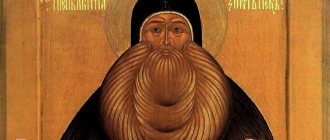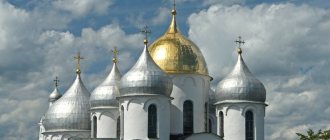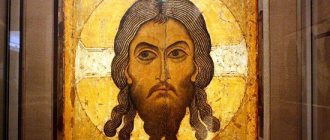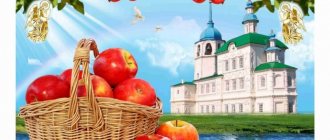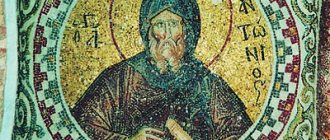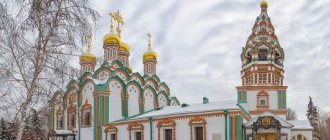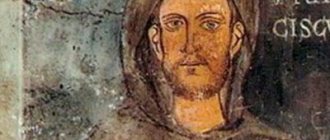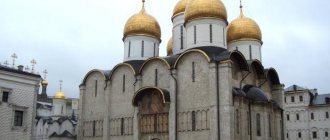Theophanes the Greek (about 1340 - about 1410) was a great Byzantine and Russian icon painter, master of monumental fresco paintings and book graphics. Having Greek origin, he received great recognition and fame on Russian soil. Considered the teacher of Andrei Rublev.
Features of the artist Feofan the Greek: The style of Feofan the Greek is distinguished by temperament, dynamic freedom, elaboration of the individuality and psychologism of each image. The master works in the accepted canon, but at the same time very boldly reforms the canon. His creativity is distinguished by the boldness of his strokes and the originality of color. The fresco paintings of Theophanes the Greek are characterized by the so-called “cursive writing”, when the painting is almost monochrome, small details, folds of clothing are not worked out, and the contours are outlined by swift lines. In his work, the two poles of Byzantine spiritual culture are often embodied - the glorification of earthly beauty as a Divine creation and the striving for spiritual asceticism, rejecting everything external and beautiful. In the frescoes, Theophanes used whitening highlights to give greater spirituality and mysticism to the faces of the saints. The overall color scheme is restrained and laconic (black, reddish-brown with shades, and white predominate), again reminiscent of a monastic, ascetic renunciation of the diversity of phenomena and colors of the world. Feofan writes in the manner of a deliberate isographer, in which icon painters relied on originals, accurately reproducing the contents of legends and writings. This artistic style allows you to create a human and, at the same time, sublime image.
Famous works of Theophanes the Greek: “Don Icon of the Mother of God”, “Assumption of the Virgin Mary”, “Savior Pantocrator”, “Transfiguration of the Lord”, “Mother of God”, “Savior in Power”, “Trinity”, “Daniel the Stylite”.
Sources of information about the master Information about the life of Theophanes the Greek, very sparse, is found in Moscow and Novgorod chronicles. Of particular value is a letter written around 1413 - 1415 by the Moscow spiritual writer and artist Epiphanius the Wise to the archimandrite of the Tver Spaso-Athanasiev Monastery and his friend Kirill Belozersky. Epiphanius's message gives an idea of the principles of the master's work and is the only source that reveals some details of the life of Theophanes the Greek. “When he depicted or wrote all this, no one saw him ever look at the samples, as some of our icon painters do, who constantly peer in bewilderment, looking here and there, and do not so much paint with paints as look at the samples. He seemed to be painting a painting with his hands, while he constantly walks, talks with those who come, and with his mind ponders the lofty and wise, while with his sensual, intelligent eyes he sees kindness. No matter how much anyone talked to him, they could not help but marvel at his mind, his allegorical “parables” and his cunning structure.” Theophan’s ability to talk while working with everyone who came, which Epiphanius admires so much, apparently made the same impression as the genius of Leonardo da Vinci made 100 years later.
Although Theophanes gained wide recognition, the dates of his life and death are always indicated only approximately. All we know for sure is that in 1413 Theophan was no longer alive, which we learn from the letter of Epiphanius the Wise mentioned above. The chronicles note all three Moscow churches in which Theophan participated in the painting: the Nativity of the Virgin Mary, Arkhangelsk and Annunciation. Epiphanius also mentions them. If, after finishing work on the Annunciation Cathedral in 1405, the Greek had time to carry out any other major work, then the chronicles, and Epiphanius, would have noted this. Therefore, the date of the master’s death lies between 1405 and 1413. Feofan died at an old age, for the first news about him - work in Novgorod - is dated 1378. He had to arrive in Russia not only as a mature artist, but also at a mature age (25-30 years old): in Byzantium he had already managed to work on a number of churches. It turns out that the date of birth of Theophanes the Greek should be sought in the range of 1335-1340, and he lived in Russia for about 40 years, where he created his most famous works.
Faith and beliefs of Theophanes the Greek
By the time of his arrival in Rus', Feofan was already inspired by the mystical teaching known as hesychasm. The word “hesychasm” comes from the Greek hesychia - “calmness”, “silence”, “detachment”. This teaching was formed in the early Byzantine era, and it could only be found in monasteries. However, in the 14th century, the teaching went beyond their limits, received theoretical justification and became accessible to the laity. Hesychasm taught that the Word of God is comprehended in silence. Refusal of verbosity, comprehension of the Word in its very depth and contemplative prayer will lead to the path of knowing God. But the main meaning of hesychasm is not the highest prayer - it was comprehended through spiritual practice and consisted of an absolute spiritual transformation, transfiguration. It is no coincidence that Theophan owns the icon of the Transfiguration of the Lord. The Tabor light, which the apostles saw during the Transfiguration of the Lord Jesus Christ, was of great importance for hesychast practice. This light, as the hesychasts said, is the inner light of transformation. “The Kingdom of God is within man” - Theophanes the Greek clearly embodies this idea in the manner of his painting. Feofan was not just a religious man, but even a deeply convinced man of the importance of spiritual strength, faith and activity, especially in the country in which he lived. And the character of the great painter matches it - tough, ascetic, reflective. Researchers note that Theophanes the Greek is characterized by a denial of optimism. He admits that man is initially sinful, therefore he can only wait with fear and humility for the decision of his fate at the Last Judgment. And these beliefs well reflect the techniques of his work.
Features of creativity
The work of Theophanes the Greek goes back to the classical Byzantine examples of the Constantinople school. His author's style was influenced by the teachings of the hesychasts, who rejected external beauty. The work of the Greek painter is characterized by the following distinctive features:
- using a small amount of colors (ochre, turquoise, crimson, white, gold);
- lack of small parts;
- work without reference to a model;
- deep symbolism of individual details and the composition as a whole.
Frescoes of the Novgorod Church of the Transfiguration, painted by Theophanes the Greek
Feofan was a philosopher and thinker focused on his inner world. The sources mention that dozens of parishioners came to see the master at work, to whom he preached the Word of God, standing on scaffolding.
Choice in favor of Rus'
Theophanes comes from Byzantium, which is why he received the nickname “Greek”. Before arriving in Rus', he had already painted forty stone churches in Constantinople, its suburbs - Chalcedon, Galata. It was in Galata, which at that time was a rich Genoese colony, that Theophanes had the opportunity to become acquainted with Western culture. He saw its palazzo and churches, observed the efficiency and free morals of the inhabitants of Galata, unusual for a Byzantine. None of Theophanes' Byzantine works have survived. From Galata the master moved first to Caffa (now Feodosia), and then to Novgorod. In Eastern Crimea, scientists still associate several surviving frescoes with him or his school. We are talking, in particular, about the painting of the Church of St. Stephen in Feodosia and a small fresco in the Church of St. John the Baptist in Kerch. Theophanes, like many of his contemporaries, could have gone to Italy, but perhaps he was not ready to part with the Orthodox faith. Staying in Byzantium, where dry academicism was increasingly established in painting, did not correspond to his individual taste and aspirations. But in Rus', which was experiencing a period of growth associated with the beginning of an active struggle for the liberation and unification of Russian lands around Moscow, a wide field of activity opened up for him. The master went to his new homeland in the retinue of Metropolitan Cyprian. The artist’s choice was completely justified: in Muscovite Rus' the name of Theophanes the Greek became the first among a galaxy of brilliant painters. He came to Rus' as a mature, established master, and not an ordinary artisan. Thanks to the work of Feofan, Russian artists were able to become acquainted with first-class examples of Byzantine art. His gift was truly original - having its origins in the Byzantine tradition, it was closely intertwined and developed in interaction with Russian culture.
general characteristics
The wave of Mongol-Tatar invasion that struck Rus' in the thirties and forties of the 13th century almost completely destroyed the flourishing culture of the principalities of southern and northeastern Rus', led to the decline of crafts and trade, and interrupted intensive economic, political and cultural ties with Byzantium, the Balkans, and Western Europe . The cities stood burned and depopulated, the population fled to the north, or to the western and northwestern Russian lands that had escaped defeat, to the Novgorod borders.
Large cities such as Chernigov and Pereyaslavl are losing their former wealth and power and are becoming deserted. Kyiv finally loses its significance as the capital of Rus', and by the end of the 13th century it only nominally continues to be its spiritual center, since the metropolitan see is transferred to Vladimir Zalessky. Those who managed to achieve greater independence from the Horde, the lands of Galician-Volyn Rus, remain faithful to Orthodoxy, but in their political, economic and cultural ties they clearly gravitate towards their western and southwestern neighbors - Poland and Hungary. Construction and artistic activity in Polotsk, which became dependent on the strengthening Lithuanian state, practically ceased. Of the most ancient cultural centers of Rus', only Novgorod retains its former role.
In the last quarter of the 13th - first third of the 14th centuries, two trends emerged in the development of art, which exist simultaneously and often intersect with each other. One of them can be called “conservative”. Everything in it is subordinated to the idea of maximum abstraction of the pictorial form and its transformation into a conventional sign, which leads to the schematization of organic plasticity, the transformation of natural movement. The other, on the contrary, is associated with attempts to achieve authenticity in the transfer of a three-dimensional form and its movement in space.
The second tendency, other artistic ideas and tastes, appear at first timidly, in a hidden form in works that, at first glance, are not very different from the monuments that represent the deepest and broadest layer of art associated with mass demand, with the everyday craft practice of icon painters.
Images of Russian painting of the 14th century. They are distinguished by exceptional emotionality, effectiveness, spiritual elation, they are filled with inspiration and impress with internal activity. This period is characterized by two most important phenomena: the renewal of intensive artistic contacts with the Byzantine world, which was most noticeable in the first half of the century, and a peculiar Russian response to the great ideas of Byzantine spirituality, especially to the concepts that spread as a result of the victory of the teachings of St. Gregory Palamas in the process of theological disputes of the middle century.
Novgorod period
Theophanes the Greek settled in Novgorod in 1370.
How did he get there, bypassing Moscow? We already know that he worked in Caffa - present-day Feodosia. Novgorodians had frequent trade relations with this city and could easily bring Feofan to themselves. The first work he completed in Rus' was the painting of the Church of the Transfiguration on Ilyin Street. This is the only work of the master that has survived to this day, which has documentary evidence dating back to 1378. This painting remains to this day the main source for judging the art of Theophanes and his artistic style, which allows for a comparative analysis to determine his authorship in other works. The painting of the Church of the Transfiguration was carried out by Feofan by order of boyar Vasily Danilovich and the townspeople and was completed in one summer. Only fragments of the original monumental ensemble of frescoes have survived to this day, but even from them one can judge the powerful creative talent of the Byzantine icon painter. The most grandiose image among the paintings of the temple is in the altar dome: this is Christ Pantocrator (Pantocrator) surrounded by four seraphim. In the drum (base of the dome) are the forefathers Abel, Adam, Noah, Seth, Enoch, the prophets Elijah and John the Baptist; in the cell are theologians and stylites. The frescoes of the Trinity Boundary (“Trinity”, “Adoration of the Sacrifice”, “Our Lady”) are the best preserved.
The Church of the Transfiguration is one of the most famous and valuable historical monuments of Novgorod. The works of Theophanes the Greek located there influenced the work of a number of painters and gave rise to followers. For example, in the famous icon “Fatherland” (14th century) there are seraphim copied from the frescoes of the Church of the Savior on Ilyin; in several works of the 15th century there are parallels with Theophan’s “Trinity”.
The talent of Theophanes the Greek was manifested not only in original artistic techniques, but also in the versatility of genres. Along with his monumental works, his miniatures became role models. “He was a deliberate book painter” - this is how Epiphanius sounds in praise. Theophanes' influence is visible in the design of such manuscripts as the “Psalter of Ivan the Terrible” (last decade of the 14th century) and “Pogodinsky Prologue” (second half of the 14th century).
The next stage of the master’s life path gives rise only to researchers’ assumptions. There is information that he lived in Nizhny Novgorod, Serpukhov, Kolomna. Works from this period have not survived to this day.
Notes
- Quote from Alpatov’s book and photographs of initial letters from the Gospel
- Our Lady of the Don on the website Christianity in Art
- “When I lived in Moscow, there lived the famous sage, the extremely cunning philosopher Theophan, a Greek by birth, a master book painter and an excellent painter among icon painters...” (Epiphanius the Wise).
Alpatov M.
V. Theophanes the Greek. - M.: Fine Arts, 1990. - P. 113 - Masters of art about art: In 4 volumes - M.-L.: IZOGIZ, 1933-1939. — T. 4. — P. 15
- Alexander Kvasnikov. Names on the Mercury chart.
- M.: AST, Astrel, 2006. - ISBN 5-17-033097-9.
Moscow period
Theophanes moved to Moscow around 1390.
By this time, he had already established his own school, students and followers appeared. Together with them, Feofan begins painting a number of Moscow churches. With the active participation of the famous Moscow icon painter Simeon Cherny, in 1395 Feofan painted the walls of the Church of the Nativity of Our Lady and the chapel of St. Lazarus in the Kremlin. Alas, this church has not been preserved, and Theophan’s frescoes in the area of St. Lazarus have been knocked down and replastered. Four years later, Theophanes the Greek, together with his students, began decorating the Archangel Cathedral, the original painting of which was also lost. Feofan's third and last major Moscow work was the painting of the Annunciation Church in the Kremlin. Here he works together with Elder Prokhor of Gorodets and Andrei Rublev, heading all the work. The event is truly historical, because two titans of medieval Russian painting met, expressing the spirit of the era with their art. Feofan - in dramatic, mournful tones, Rublev - in harmonious, bright, embodying the dream of peace and harmony. In the Annunciation Church, Theophanes owns the compositions “Apocalypse” and “Root of Jesse”. According to tradition, he is also credited with the authorship of the icons of the Deesis order from the Annunciation iconostasis, while Andrei Rublev worked on icons depicting holidays. However, the iconostasis not only retained the general design and harmonious composition, but also became a unique phenomenon. This was the first iconostasis in Russia with full-length depictions of saints, and Theophanes the Greek and Andrei Rublev became the creators of the classical form of the Russian iconostasis. And, if the original painting of the temple itself has not reached us, then this iconostasis has still been preserved. Theophanes the Greek can be considered the creator of the new image of “Tenderness”. The icon “Our Lady of the Don” (a modification of “Tenderness”, another name is “The Joy of All Joys”), which was the revered altarpiece of the Assumption Cathedral in Kolomna, is considered by researchers to be a prototype. The icon itself is double-sided - on the reverse side is the “Assumption of the Mother of God”. The Assumption Cathedral of Kolomna was built on the eve of the Battle of Kulikovo, and later, after the victory and giving Prince Dmitry Ioannovich the nickname Donskoy, the church and the icon of “Our Lady of Tenderness” also began to be called Donskoy. Ivan the Terrible highly revered this icon, took it with him on the Kazan campaign, and in 1591 it was carried out during the battle with Kazy-Girey. When the battle ended with the victory of the Russians, “Our Lady of the Don” was recognized as miraculous. The glorified image was transferred to the Annunciation Cathedral of the Moscow Kremlin. The icon has not been forgotten even today. In the 20th century, during the German offensive, on the orders of I.V. Stalin, she flew three times on an airplane over Moscow. Now this masterpiece is kept in the Tretyakov Gallery.
In Moscow, Feofan, as in Novgorod, probably also worked on book graphics. Based on the characteristic sharp lines and color, it is believed that the design of the Gospel of boyar Fyodor Koshka, with its ornamental decorations, headpieces and zoomorphic initials, also belongs to Feofan. Regarding another famous manuscript - the Khitrovo Gospel, they say that the work was most likely done by one of Theophanes' followers, possibly Andrei Rublev.
School of Theophanes the Greek
Theophanes the Greek lived in Russia for almost half a century and wrote his most famous works for it.
If all of them had been preserved, then Theophanes’ legacy would have been quite great. Of course, he did not work alone, but formed an entire school. Theophanes the Greek willingly passed on his knowledge, experience, and he had no shortage of students. Based on the letter of Epiphanius the Wise, we can confidently assume that the master knew how to easily win over his interlocutors, was open, benevolent and good-natured. In addition, “Theophanes the Iconist Gregin the Philosopher” enjoyed great prestige as an artist-thinker. The greatest of his students was Andrei Rublev. When painting the Annunciation Cathedral, he acted as an assistant, not a student. However, the technical similarity of their works, especially the use of “cabbage cabbage” - a blue paint of an unusually bright tone, indicates that Rublev was for some time a student of Feofan. Such an intense blue color cannot be obtained from the usual icon palette. Feofan can see it on the board of “Our Lady of the Don”. After it, this color cannot be found anywhere else, with the exception of Rublev’s “Trinity,” which confirms the closeness of their work and the exceptional role of Feofan in the development of medieval Russian painting. And in the history of Russia itself, this Byzantine remained as outstanding a personality as he was mysterious. Author: Irina Frykina
